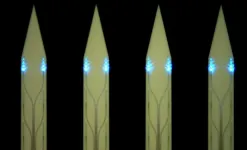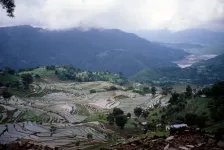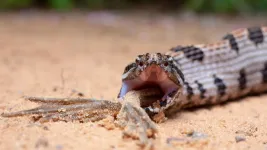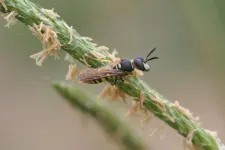How many Anthropocenes
2021-04-19
(Press-News.org) One of the marks of a successful idea in science is how quickly it can develop and evolve. In the case of the Anthropocene, the conceptual evolution has taken place with extraordinary speed. The strikingly influential hypothesis launched by the late Nobel laureate Paul Crutzen (Obituary, 24th Feb 2021) in 2000, was that the actions of an industrialised humanity has impacted the Earth so greatly as to trigger a new geological epoch. Originally developed within the Earth System science community in charting global environmental change, the Anthropocene then began to be analysed by geologists to see whether it really could be accepted, formally, on to the Geological Time scale--ongoing work steered from the outset by a University of Leicester team (Professors Zalasiewicz, Waters, Williams) and other UK and international scholars. "It quickly spread widely across the sciences, humanities and arts, including to become a central framing concept of the IPCC, the UN Environment Programme and in international law", Waters explains. With such profound influence across so many different communities, of such different backgrounds and perspectives, though, came large questions about what the Anthropocene is, and when it started.
Originally Crutzen suggested it began as the Industrial Revolution commenced in the late 18th century, but subsequent analysis by the Anthropocene Working Group (AWG), has refined this estimate. "The greatest changes, of population, industrialization, globalization have taken place with the 'Great Acceleration' of the boom post-WWII years of the mid-20th century", Zalasiewicz explained. "In that brief spell--a little less than one average human lifetime--humanity has burned through more energy than in the previous 12 millennia and more", Williams said. This is driving the physical, chemical and biological changes to Earth that are now destabilizing the biosphere and climate, leaving records in modern-day strata, including plastics, concrete and supermarket chicken bones that justify the Anthropocene in geology.
But look at the Anthropocene from more human-based perspectives, and one can foreground human impacts on the environment that go back thousands of years. So should the beginning of the Anthropocene be pushed back to these earliest impacts, of the felling of forests, or the domestication of animals, or the spread of farmland soils, or of the linking of the New World with the Old? "All these ideas, and more, have emerged, in intense discussions that have erupted around this vivid and powerful new concept--each of which puts it in a different light", new AWG member Jens Zinke (UofL) adds. What, then, is the Anthropocene?
A new paper from the AWG, representing a wide range of academic disciplines, faces up to this conundrum, the playing out of which will determine how the Anthropocene will survive in human thinking. "Dissecting the many interpretations of the Anthropocene suggests that a range of quite distinct, but variably overlapping, concepts are in play", Waters noted. The debate has broken many barriers between academic disciplines--but also led to the risk of confusion of different meanings of the term. How should this be resolved? The authors encourage more debate across various disciplines--and suggest that eventual formalization of the Anthropocene in geology would help stabilize its interpretation and use, including to help societies to navigate the many challenges of the emerging Anthropocene world.
INFORMATION:
ELSE PRESS RELEASES FROM THIS DATE:
2021-04-19
April 19, 2021 -- Ensuring COVID-19 vaccine access for refugee and displaced populations, and addressing health inequities, is vital for an effective pandemic response. Yet, vaccine allocation and distribution has been neither equitable nor inclusive, despite that global leaders have stressed this as a critical aspect to globally overcoming the pandemic, according to a paper published by Columbia University Mailman School of Public Health. Read "Leave No-one Behind: Ensuring Access to COVID-19 vaccines for Refugee and Displaced Populations" in the journal Nature Medicine.
As of April 1st, high and upper-middle-income countries received 86 percent of the vaccine doses delivered worldwide, while ...
2021-04-19
Tools that allow neuroscientists to record and quantify functional activity within the living brain are in great demand. Traditionally, researchers have used techniques such as functional magnetic resonance imaging, but this method cannot record neural activity with high spatial resolution or in moving subjects. In recent years, a technology called optogenetics has shown considerable success in recording neural activity from animals in real time with single neuron resolution. Optogenetic tools use light to control neurons and record signals in tissues that are genetically modified ...
2021-04-19
A group of scientists have just made a key discovery that could prevent and eradicate immune responses that lead to treatment failure in about one-third of people with severe hemophilia A.
Hemophilia is the most common severe inherited bleeding disorder in men. The disease affects 1 in 10,000 males worldwide and results from deficiency of blood clotting factor VIII (FVIII). Both children and adults with hemophilia A (80 percent of all hemophilia) receive treatment that involves infusing FVIII protein into the bloodstream. However, about 30 percent ...
2021-04-19
Our planet's worst mass extinction event happened 252 million years ago when massive volcanic eruptions caused catastrophic climate change. The vast majority of animal species went extinct, and when the dust settled, the planet entered the early days of the Age of Dinosaurs. Scientists are still learning about the patterns of which animals went extinct and which ones survived, and why. In a new study in PNAS, researchers found that while extinctions happened rapidly in the oceans, life on land underwent a longer, more drawn-out period of extinctions.
"People assumed that because the marine extinction happened over a short period of time, life on land should have followed the same pattern, but we found that the marine extinction ...
2021-04-19
Professor Nicole Boivin, Director of the Department of Archaeology at the Max Planck Institute for the Science of Human History in Jena, Germany, is part of an international initiative to examine the implications of past land use for contemporary conservation efforts.
The multi-disciplinary team, which includes archaeologists, ecologists, anthropologists and conservation managers, has reconstructed ancient population and land use to show that already by 12,000 years ago, humans had re-shaped much of the terrestrial biosphere.
Their data challenge the idea that conservation ...
2021-04-19
New research published today in the Proceedings of the National Academy of Sciences (PNAS) shows that land use by human societies has reshaped ecology across most of Earth's land for at least 12,000 years. The research team, from over ten institutions around the world, revealed that the main cause of the current biodiversity crisis is not human destruction of uninhabited wildlands, but rather the appropriation, colonization, and intensified use of lands previously managed sustainably.
The new data overturn earlier reconstructions of global land use history, some of which indicated that most of Earth's land was uninhabited even as recently as 1500 CE. Further, ...
2021-04-19
Diversity in diet plays a role in the complexity of venom in pit vipers such as rattlesnakes, copperheads and cottonmouths.
But new collaborative research by Clemson University scientists found the number of prey species a snake ate did not drive venom complexity. Rather, it was how far apart the prey species were from each other evolutionarily.
"It's not just diet that drives the variation in venom across snakes. It's the breadth of diet," said Christopher Parkinson, a professor in the College of Science's Department of Biological Sciences. "If a snake eats 20 different species of mammals, its venom will not be very complex. But if it eats a centipede, a frog, a bird and a mammal, it's going to have a highly complex venom because each component of that venom ...
2021-04-19
Antibiotics on the cocoon protect the offspring of beewolves, a group of digger wasps, from detrimental fungi. These protective substances are produced by symbiotic bacteria of the genus Streptomyces, which live in these insects. In a new study in PNAS, researchers from the Max Planck Institute for Chemical Ecology and the University of Mainz, together with an international team, showed that these beneficial bacteria are losing genetic material that is no longer needed. The genome of these bacteria is of great interest for understanding the process of genome erosion and elucidating how the cooperation and the mutual benefit between bacteria and their host insects have evolved over long periods of time (PNAS, doi: 10.1073/pnas.2023047118, ...
2021-04-19
Police violence against Black Americans is shamefully common in the United States and devastates communities. For incidents that get widespread media exposure, a collective trauma is felt across the nation, especially for Black individuals. Research supports that experiencing racism even vicariously can harm the mental and physical health of others of the same racial group, yet its effect on a population level is unclear.
A new study analyzed how highly publicized acts of racial violence impacted the mental health of Black Americans in the U.S. The authors identified 49 incidents that occurred between 2013 and 2017, including police killings of Black individuals, hate-crime murders and decisions not to indict or convict the officers involved. The researchers measured ...
2021-04-19
What keeps some plants squatting close to the soil while others - even those closely related - reach high for the skies?
New research addressing the architecture and growth habit of plants has provided an answer to this question and may assist in the development of better performing crops.
The way plants grow must sometimes satisfy contradictory needs. Growing close to the ground, decreases the chances of being grazed, but this presents the need to rise rapidly to allow seeds to disperse. This can be observed in dandelions and in Arabidopsis, a model species commonly used to study plant development.
Agriculture has taken advantage of the diversification of growth habit so that ...
LAST 30 PRESS RELEASES:
[Press-News.org] How many Anthropocenes





